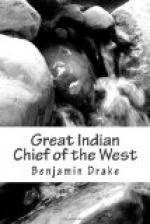for this act of youthful valor, he was, for the first
time, permitted to mingle in the scalp-dance.
This triumph was followed shortly afterwards by two
more excursions against the same tribe. In the
first, Black Hawk was the leader of seven men, who
suddenly attacked a party of one hundred Osages, killed
one of them, and as suddenly retreated without loss.
This exploit, so far increased the number of his followers,
that he soon afterwards started with a party of one
hundred and eighty braves, and marched to an Osage
village, on the Missouri; but found it deserted.
Most of the party being disappointed, left their leader
and returned home. Black Hawk, however, with
but five followers, pursued the trail of the enemy,
and after some days succeeded in killing one man and
a boy; and, securing their scalps, returned home.
In the year 1786, having recovered from the effect
of his late unsuccessful excursion, Black Hawk found
himself once more at the head of two hundred braves,
and again set off to avenge the repeated outrages of
the Osages upon the Sac nation. Soon after he
reached the enemy’s country, he met a party
about equal in number to his own. A battle ensued.
The Osages lost near one hundred men, and Black Hawk
nineteen. He claims, in the attack, to have killed
five of the enemy, with his own hand. This severe
engagement had the effect, for some time, of keeping
the Osages upon their own lands and arresting their
depredations upon the Sacs. This cessation of
hostilities gave the latter an opportunity of redressing
the wrongs which the Cherokees had committed upon
them, by murdering some of their women and children.
A party was raised for this purpose, and met the Cherokees
upon the Merrimack river, below St. Louis, the latter
being most numerous. In this battle Py-e-sa,
the father of Black Hawk was killed. The Cherokees
were compelled to retreat with the loss of twenty-eight
men, the Sacs having but seven killed. Upon the
fall of Py-e-sa, Black Hawk assumed the command and
also took possession of the “medicine bag,”
then in the keeping of his father. Owing to the
disasters of this expedition, and especially the death
of his father, Black Hawk, for the ensuing five years,
refrained from all warlike operations, and spent his
time in fishing and hunting. At the end of this
period, being about the year 1800, he made another
excursion, against the Osages, at the head of about
five hundred Sacs and Foxes and a hundred Ioways,
who had joined him as allies. After a long march
they reached and destroyed about forty lodges of the
enemy, killing many of their bravest warriors, five
of whom were slain by the leader of the invading army.
In the year 1802, he terminated a severe and protracted
campaign against the Chippewas, Kaskaskias and Osages,
during which six or seven battles were fought and
more than one hundred of the enemy killed. The
following summer Black Hawk made one of his periodical
visits to St. Louis to see his Spanish father, by whom




